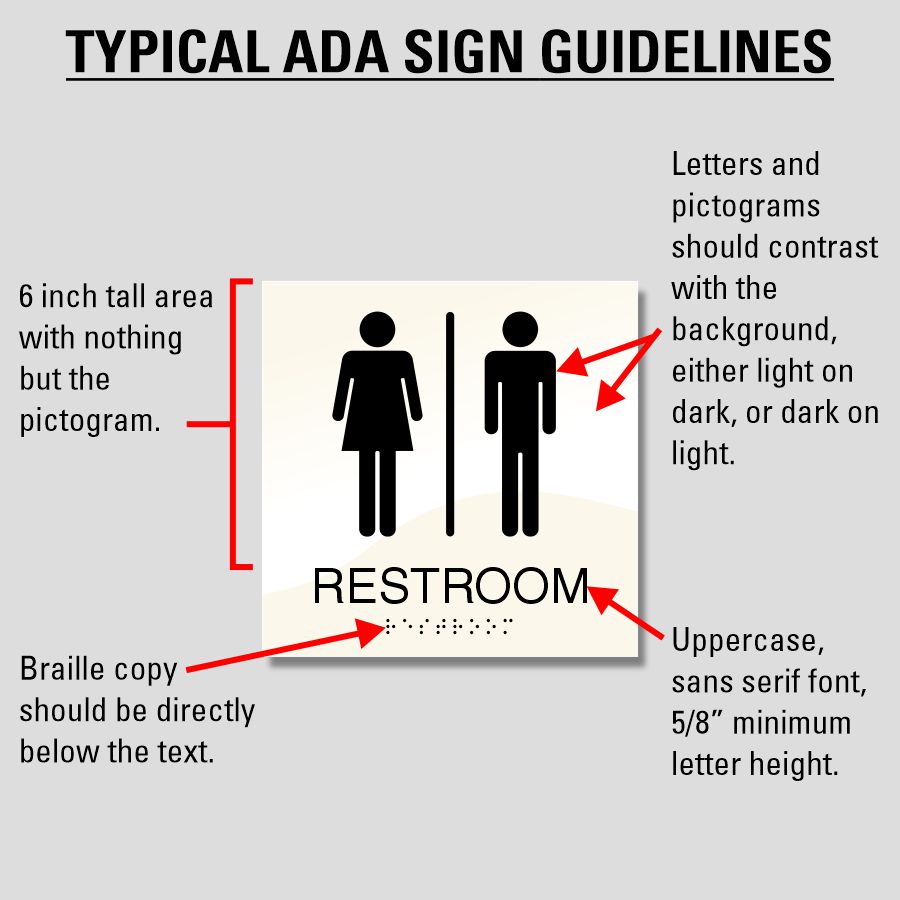Exactly How ADA Signs Improve Access for Everyone
Exploring the Secret Features of ADA Indications for Enhanced Accessibility
In the world of ease of access, ADA indications offer as quiet yet effective allies, ensuring that spaces are comprehensive and accessible for individuals with impairments. By incorporating Braille and responsive aspects, these indications damage obstacles for the visually impaired, while high-contrast shade systems and clear fonts provide to varied visual demands.
Importance of ADA Conformity
Making sure compliance with the Americans with Disabilities Act (ADA) is important for promoting inclusivity and equivalent gain access to in public areas and offices. The ADA, established in 1990, mandates that all public facilities, companies, and transport solutions accommodate individuals with specials needs, guaranteeing they enjoy the exact same legal rights and possibilities as others. Conformity with ADA standards not just meets lawful obligations but likewise improves a company's online reputation by demonstrating its commitment to diversity and inclusivity.
One of the key aspects of ADA conformity is the application of available signage. ADA signs are made to make certain that individuals with impairments can conveniently browse via rooms and buildings.
In addition, sticking to ADA regulations can minimize the danger of prospective penalties and legal effects. Organizations that stop working to abide by ADA standards may encounter charges or lawsuits, which can be both monetarily troublesome and destructive to their public picture. Thus, ADA conformity is indispensable to promoting an equitable setting for everybody.
Braille and Tactile Elements
The unification of Braille and responsive elements into ADA signage symbolizes the concepts of accessibility and inclusivity. It is normally placed below the equivalent message on signage to ensure that individuals can access the info without aesthetic help.
Tactile elements expand past Braille and consist of increased symbols and personalities. These parts are created to be noticeable by touch, enabling individuals to identify room numbers, restrooms, departures, and other vital areas. The ADA sets details standards concerning the size, spacing, and positioning of these responsive elements to enhance readability and guarantee consistency throughout different environments.

High-Contrast Color Pattern
High-contrast color systems play an essential role in improving the visibility and readability of ADA signs for individuals with aesthetic disabilities. These plans are essential as they make best use of the difference in light reflectance in between text and history, guaranteeing that signs are easily discernible, also from a distance. The Americans with Disabilities Act (ADA) mandates the usage of particular color contrasts to fit those with minimal vision, making it a vital facet of conformity.
The effectiveness of high-contrast colors exists in their capacity to attract attention in various lights problems, consisting of dimly lit environments and areas with glow. Usually, dark message on a light background or light text on a dark background is used to achieve ideal comparison. For example, black message on a yellow or white background offers a plain aesthetic difference that aids in fast recognition and understanding.

Legible Fonts and Text Dimension
When considering the design of ADA signs, the selection of readable font styles and ideal text dimension can not be overemphasized. These aspects are essential for guaranteeing that signs are accessible to individuals with visual problems. The Americans with Disabilities Act (ADA) mandates that typefaces have to be sans-serif and not italic, oblique, manuscript, extremely attractive, or of unusual form. These requirements assist make certain that the message is easily understandable from a distance and that the personalities are distinct to varied target markets.
The dimension of the message likewise plays an essential role in ease of access. According to ADA guidelines, the minimal message height ought to be 5/8 inch, and it should increase proportionally with watching distance. This is especially vital in public rooms where signage requirements to be read quickly and accurately. Uniformity in message size contributes to a natural visual experience, aiding people in browsing atmospheres successfully.
In addition, spacing between lines and letters is important to legibility. Appropriate spacing prevents personalities from showing up crowded, boosting readability. By sticking to these requirements, developers can considerably boost access, ensuring that signs offers its intended function for all people, no matter their aesthetic capabilities.
Efficient Positioning Strategies
Strategic positioning of ADA signs is crucial for maximizing ease of access and making sure compliance with legal standards. ADA standards state that indications should be mounted at an elevation in between 48 to 60 inches from the ground to ensure click to read they are within the line of view for both standing and seated people.
In addition, signs have to be put adjacent to the lock side of doors to allow simple identification prior to entry. Uniformity in indication placement throughout a center enhances predictability, lowering confusion and boosting overall individual experience.

Final Thought
ADA signs play an important function in advertising availability by incorporating features that attend to the needs of individuals with specials needs. Including Braille and tactile elements ensures vital information comes to the aesthetically damaged, while high-contrast color design and readable sans-serif typefaces enhance visibility across different illumination conditions. Efficient positioning approaches, such as appropriate mounting heights and tactical locations, additionally promote navigating. These components jointly cultivate a comprehensive atmosphere, underscoring the value of ADA conformity in making sure equivalent gain access to for all.
In the realm of access, ADA indicators offer as silent yet effective allies, making certain that areas are inclusive and visit this site navigable for people with specials needs. The ADA, passed in 1990, mandates that all public facilities, companies, and transport services suit individuals with disabilities, guaranteeing they take pleasure in the same civil liberties and chances as others. ADA Signs. ADA signs are designed to make sure that individuals with handicaps can conveniently navigate via structures and areas. ADA standards state that signs need to be installed at a height in between 48 to 60 inches from the ground to ensure they are within the line of view for both standing and seated people.ADA indicators play an essential duty in advertising ease of access by incorporating attributes that attend to the needs of people with impairments